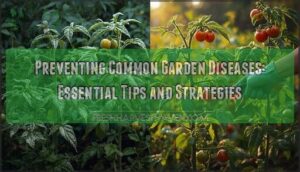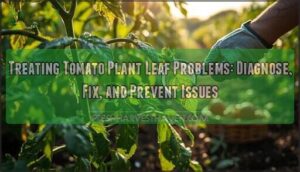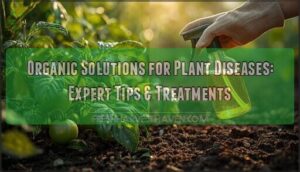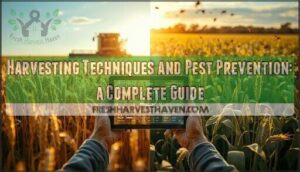This site is supported by our readers. We may earn a commission, at no cost to you, if you purchase through links.

A white coating appears on your tomato leaves overnight. Within days, those vibrant plants you nurtured from seedlings are struggling to survive. Garden diseases don’t announce themselves with warning signs—they attack when conditions align, turning healthy beds into problem zones faster than most gardeners realize.
The good news: most outbreaks are preventable. Understanding how pathogens spread and what conditions trigger infections gives you the upper hand. Disease-resistant varieties, strategic watering, proper spacing, and consistent sanitation create barriers that keep your plants thriving. Master these fundamentals, and you’ll spend less time fighting infections and more time enjoying abundant harvests.
Table Of Contents
- Key Takeaways
- Recognizing Common Garden Diseases
- Choosing Disease-Resistant Plants
- Optimizing Garden Environment
- Effective Sanitation and Garden Maintenance
- Integrated Pest and Disease Management
- Frequently Asked Questions (FAQs)
- What are the 5 principles of plant disease control?
- How to prevent plant disease symptoms?
- What is the best method for controlling plant disease?
- What are the preventive measures of plant disease control?
- How do you prevent garden diseases?
- Are garden diseases curable?
- How do you prevent pathogens in plants?
- How can a healthy plant survive a disease?
- How do you care for plants in a garden?
- How do I Keep my plants healthy?
- Conclusion
Key Takeaways
- Most garden diseases are preventable through strategic practices like choosing disease-resistant varieties, proper plant spacing for airflow, consistent watering schedules (ideally 5-9 a.m.), and maintaining clean tools with 10% bleach or 70% alcohol between uses.
- Early detection through daily inspections is critical since fungal infections like powdery mildew, bacterial diseases like fire blight, and viral symptoms can destroy entire crops within days if left unchecked.
- Crop rotation dramatically reduces soil-borne pathogens—three-year rotations cut bacterial spot by 67% and four-year cycles reduce fusarium by 52%—while mulching with straw or wood chips blocks spore splash and lowers fungal infections by up to 51%.
- Integrated pest management targeting insect vectors like aphids and whiteflies reduces viral disease transmission by 60%, especially when combined with biological controls like beneficial insects and preventive organic treatments applied every 7-14 days.
Recognizing Common Garden Diseases
Catching a garden disease early can mean the difference between losing a single leaf and watching your entire crop wither away. Train your eye to spot trouble before it spreads. Fungal infections like powdery mildew show up as white, dusty coatings on leaves, while leaf spot creates yellow or brown lesions that grow over time. Root rot, another common fungal disease, strikes below ground when soil stays too wet.
Bacterial diseases such as fire blight cause sudden wilting and blackened stems. Viral symptoms are trickier—look for mottled leaves, stunted growth, or distorted foliage that signals mosaic virus or leaf curl.
Garden pathogens don’t announce themselves with fanfare, so make daily inspections part of your routine. The sooner you identify plant diseases, the better your chances of containing them.
Choosing Disease-Resistant Plants
One of the smartest moves you can make is selecting plants that naturally resist disease. These varieties won’t eliminate every problem, but they’ll give you a serious head start in keeping your garden healthy.
Let’s look at what makes disease-resistant plants worth choosing, how to pick the right ones for where you live, and where to find quality stock.
Benefits of Disease-Resistant Varieties
Disease-resistant varieties transform your plant health management strategy. You’ll slash chemical use by up to 70% while boosting crop yields 20-30% under disease pressure.
These resistant plant varieties deliver economic savings—reducing gardening costs by 30% annually—and environmental benefits through decreased runoff. Best of all, they increase food safety by cutting pesticide residues 40%, making disease prevention both practical and rewarding.
By utilizing disease resistant varieties, gardeners can effectively manage and prevent common garden diseases.
Selecting The Right Plants for Your Region
Matching plants to your region strengthens disease resistance naturally. Native plant benefits shine here—gardens with 70% native species show striking ecological balance and fewer infections. Regional adaptation matters because climate-matched varieties demonstrate 40% higher survival rates and better local disease resistance. By incorporating more native plant species, gardeners can boost biodiversity and ecosystem health.
- Choose plants evolved for your specific climate and soil conditions
- Prioritize native species that support natural pest control and ecosystem health
- Select resistant plant varieties bred for diseases common in your area
Sourcing Healthy Seedlings and Cuttings
Once you’ve picked the right varieties, don’t undermine your efforts with compromised starts. Seedling inspection at purchase catches problems early—look for vigorous growth and clean foliage. Source from disease-free nurseries offering certified stock whenever possible.
Healthy plant material reduces disease transmission by up to 73%, giving your garden a clean foundation. Quality seed quality and cutting propagation practices protect your investment from day one.
Optimizing Garden Environment
Your garden’s physical environment plays a starring role in whether diseases take hold or stay at bay. When you get spacing, watering, soil, and mulching right, you create conditions where plants thrive and pathogens struggle.
Let’s walk through the key environmental factors you can control to keep your garden healthy.
Proper Plant Spacing and Air Circulation
Think of crowded plants like a stuffy room—moisture lingers, and trouble follows. Proper Plant Spacing improves Air Circulation around foliage, drying leaves faster and lowering humidity that fuels Powdery Mildew and Leaf Spot.
Crowded plants trap moisture like stuffy rooms, creating the perfect conditions for powdery mildew and leaf spot to thrive
Better airflow reduces Foliage Density, creating a healthier Microclimate Management zone that discourages Fungal Infections.
Space tomatoes about 50 feet apart and brassicas 20 feet to slash disease risk dramatically while boosting Soil Aeration.
Managing Moisture and Watering Practices
When you water matters just as much as how much. Water wisely between 5 a.m. and 9 a.m. to minimize leaf wetness and disease risk, aiming for about 1 inch weekly through thoughtful wetting cycles that promote deep root growth.
- Drip irrigation cuts water loss by 60% while keeping foliage dry
- Monitor soil moisture 6 inches deep to avoid overwatering and root rot
- Mulch benefits include slower evaporation and better water conservation
- A consistent watering schedule fosters healthy water management practices
Soil Health and Drainage Improvement
Your soil’s structure determines whether roots thrive or struggle with disease. Improve drainage by mixing 2-4 inches of compost or pine bark into heavy soils, enhancing both soil aeration and microbial balance. These organic matter additions prevent compaction while boosting water management—your roots get oxygen even after rain.
Test drainage by filling a hole with water; it should drain within 12 hours for ideal root health.
Mulching to Prevent Soil-Borne Diseases
Mulch acts as your first line of defense against soilborne diseases, cutting fungal infections by up to 51% within two years. Straw or wood chips create organic barriers that block pathogen spores from splashing onto leaves while moderating soil temperature and moisture control.
These mulch types also release compounds during decomposition that directly inhibit harmful organisms, improving overall soil health and pathogen reduction naturally.
Effective Sanitation and Garden Maintenance
Think of sanitation as your garden’s first line of defense—it’s not glamorous, but it stops diseases before they take hold. Simple habits like cleaning your tools and staying on top of garden clutter make a real difference in keeping plants healthy.
Here are four essential maintenance practices that’ll help you stay ahead of disease problems.
Cleaning and Sterilizing Tools
Your tools can spread more disease than any pest. Clean them after every use—scrub off soil and sap, then disinfect with a 10% bleach solution or 70% alcohol.
Sterilization techniques matter most when moving between plants. A quick wipe prevents bacterial canker, fire blight, and viral infections from hitching a ride.
Equipment maintenance isn’t optional; it’s your first defense in garden maintenance and smart plant care.
Removing Infected Plants and Debris
Once you spot infection, act fast—remove the entire plant, roots and all. Infected debris harbors pathogens that can reinfect your garden season after season.
Don’t compost diseased material; pathogens often survive the heat. Instead, bag it and dispose of it away from your planting areas.
Proper plant disposal and debris management are your best sanitation methods for effective fungal disease treatment and long-term garden disease prevention.
Timely Pruning and Weed Control
After clearing away infected debris, your next line of defense is regular pruning and weed control—two pillars of strong garden hygiene and plant sanitation. Pruning techniques improve air circulation and remove disease hotspots, while weed management cuts off pathogen hosts before they spread trouble. Together, they form a powerful erosion control strategy against future outbreaks.
Here are five gardening tips for timely pruning and weed control:
- Prune during dormancy—late winter or early spring minimizes stress and accelerates wound healing.
- Sterilize tools between cuts to prevent pathogen transmission across plants.
- Avoid pruning in wet conditions; moisture invites infection through fresh wounds.
- Remove weeds before planting to lower disease reservoirs and inoculum pressure.
- Target high-risk weed species that harbor fungi, reducing your overall disease prevention workload.
Consistent attention to these practices strengthens your garden’s natural defenses.
Rotating Crops to Minimize Disease Build-Up
Beyond pruning and weeding, rotating crops is your most powerful soil pathogen control tool. Switching plant families each season disrupts disease cycles by starving pathogens of their preferred hosts.
USDA research shows bacterial spot drops 67% with three-year rotations, while fusarium declines 52% in four-year cycles. These crop rotation benefits restore microbial balance and prevent the nutrient depletion that weakens defenses.
Smart rotational planning strategies keep your soil healthy and resilient.
Integrated Pest and Disease Management
Managing garden pests isn’t just about eliminating bugs—it’s about breaking the disease cycle they fuel. Insects like aphids, leafhoppers, and whiteflies act as mobile disease carriers, spreading viruses and bacteria from plant to plant.
Here’s how to take control with smart, sustainable strategies that protect your garden before problems spiral out of hand.
Controlling Insect Vectors (Aphids, Leafhoppers, Whiteflies)
Regularly, you’ll find aphids, leafhoppers, and whiteflies spreading viral diseases throughout your garden—over 80% of plant pathogenic viruses depend on these piercing-sucking insects for transmission.
Managing vector populations through Integrated Pest Management and Biological Pest Management reduces disease incidence by 60%.
Focus on early detection, habitat manipulation, and deploying predatory insects to control Aphid Transmitted Viruses and other Vector Borne Diseases threatening Plant Health and Wellness.
Implementing Organic and Preventive Treatments
Once you’ve knocked back insect vectors, protect your plants with organic treatment options before diseases take hold. Apply copper fungicides or neem oil every 7-14 days as preventive sprays—they’re cornerstones of organic gardening methods.
Biofungicide applications work beautifully for fungal disease treatment while supporting soil health management. These integrated pest management strategies stop pathogens before symptoms appear, keeping your garden thriving naturally.
Monitoring and Early Intervention Strategies
Check your plants weekly for early warning signs like yellow spots or wilted leaves—catching infections early can save thousands per hectare in treatment costs.
Keep detailed records of what you see and when, because disease surveillance helps you spot patterns before outbreaks explode.
With pathogen tracking and forecasting models guiding intervention timing, you’ll control problems while they’re still manageable.
Using Biological Controls and IPM Practices
Biological Pest Control through IPM Strategies transforms your garden into a self-regulating ecosystem. Deploy beneficial insects like lady beetles and parasitoid wasps for natural enemy enhancement, while Trichoderma and Bacillus species tackle fungal disease management at the root level.
These biological control methods reduce pest populations by 63% without synthetic fungicides.
Combine cultural controls in gardening—crop rotation, proper spacing—with organic gardening methods for resilient pest management that actually works.
Frequently Asked Questions (FAQs)
What are the 5 principles of plant disease control?
The five core principles of plant disease control are exclusion methods, avoidance techniques, eradication strategies, protection measures, and resistance breeding.
Together, these disease prevention strategies form an integrated approach to keeping your garden healthy.
How to prevent plant disease symptoms?
You can prevent plant disease symptoms by selecting disease-free plants, improving soil health with beneficial microbes, ensuring proper drainage for healthy root growth, and applying preventive fungicides before pathogens arrive.
What is the best method for controlling plant disease?
Integrated Pest Management combines cultural practices, biological controls, and targeted fungicides to achieve effective plant disease control.
This approach tackles pathogen genetics and microbial ecology while supporting plant immunology through strategic disease prevention strategies.
What are the preventive measures of plant disease control?
Picture your garden thriving without blight or mildew. Disease forecasting through crop monitoring, soil testing, biological controls, and timely fungicide application form a layered defense—cutting infection rates while keeping plants naturally resilient.
How do you prevent garden diseases?
You’ll protect your plants by focusing on garden hygiene, proper spacing, and soil testing. Choose resistant varieties, water wisely, rotate crops, and monitor regularly.
Disease forecasting and plant nutrition strengthen your preventive measures for healthy gardens.
Are garden diseases curable?
Here’s the hard truth: most garden diseases aren’t curable once they take hold. Fungal infections and bacterial diseases can sometimes achieve disease remission with fungicides, but viral cure remains impossible. Nanotech treatments show promise, yet disease prevention strategies beat plant disease control every time.
Focus your efforts on disease management strategies through plant pathology principles—stopping problems before they start wins the battle.
How do you prevent pathogens in plants?
You can prevent pathogens by using pathogen-free soil, maintaining microbial balance, and supporting plant immune systems through healthy root growth.
Focus on fungal disease prevention, proper drainage, and selecting disease-resistant varieties for effective plant disease control.
How can a healthy plant survive a disease?
Strong immunity allows plants to survive disease through genetic resistance mechanisms that recognize pathogens and activate defenses like antimicrobial compounds.
Disease tolerance improves with balanced nutrient uptake, fungal resistance, and bacterial defense systems that bolster plant health.
How do you care for plants in a garden?
Garden planning starts with soil health—test your pH and drainage first.
Water management, plant nutrition, and pest control form your foundation.
Regular monitoring catches problems early, ensuring your gardening best practices keep plants thriving year-round.
How do I Keep my plants healthy?
You can keep your plants healthy through regular soil testing, proper fertilizer management, and consistent pest control.
Monitor water quality, maintain soil health, and apply disease prevention strategies to support ideal plant nutrition and growth.
Conclusion
Your garden is a living defense system—each practice you implement adds another layer of protection against disease. Preventing common garden diseases isn’t about flawlessness; it’s about consistency.
Choose resistant varieties, manage moisture carefully, maintain clean tools, and monitor plants regularly. These strategies work together like interlocking shields, creating conditions where pathogens struggle to gain footholds.
The time you invest in prevention pays dividends in healthy plants and productive harvests. Your best defense starts with informed action today.
- https://www.extension.iastate.edu/news/2005/jun/071602.htm
- https://extension.umn.edu/plant-diseases/aster-yellows
- https://www.idyl.co.in/blogs/blog/grow-healthier-vegetables-a-guide-to-disease-resistant-varieties
- https://smallfarms.cornell.edu/2010/10/another-tool-for-your-disease-management-toolbox-disease-resistant-varieties/
- http://www.ers.usda.gov/data-products/adoption-of-genetically-engineered-crops-in-the-united-states/recent-trends-in-ge-adoption







